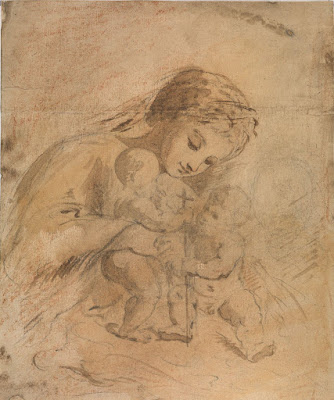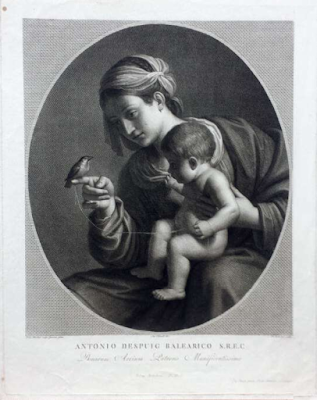 |
| Guercino (Giovanni Francesco Barbieri) Virgin offering a Rosebud to the Infant Christ ca. 1615-16 detached fresco Fondazione Cassa di Risparmio, Bologna |
"This painting, still housed in its original octagonal wooden frame with deep sides, was formerly inserted into a wall of the main staircase of the Palazzo Malvezzi Campeggi, Rome, having been brought there by a member of the Malvezzi family of Bologna, probably before World War II. . . . In 1994, the owners, anxious about theft, had the fresco detached, and some ten years later it was sold to the Fondazione Cassa Risparmio di Bologna."
 |
| Guercino (Giovanni Francesco Barbieri) Virgin offering a Rosebud to the Infant Christ ca. 1615-16 drawing (compositional study) Ashmolean Museum, Oxford |
 |
| Guercino (Giovanni Francesco Barbieri) Virgin offering a Rosebud to the Infant Christ ca. 1615-16 drawing (compositional study) Musée du Louvre |
 |
| Guercino (Giovanni Francesco Barbieri) Holy Family ca. 1615-16 oil on canvas Galleria Palatina, Palazzo Pitti, Florence |
 |
| anonymous copyist after Guercino Virgin and Child with the Infant St John the Baptist ca. 1615-16 oil on canvas Royal Collection, Hampton Court Palace, London |
 |
| Guercino (Giovanni Francesco Barbieri) Virgin and Child with the Infant St John the Baptist ca. 1615-16 drawing (compositional study) Nasjonalgalleriet, Oslo |
 |
| Guercino (Giovanni Francesco Barbieri) Virgin and Child with the Infant St John the Baptist ca. 1615-16 drawing (compositional study) private collection |
 |
| Guercino (Giovanni Francesco Barbieri) Virgin and Child with the Infant St John the Baptist ca. 1615-16 drawing (compositional study) Rijksmuseum, Amsterdam |
At least in reproduction, as here, Guercino's early drawings are often more alluring than his early paintings. The believable tenderness of the many Madonna sketches, for example, morphed often enough toward saccharine convention when carried through in paint. As the artist moved farther into his twenties, the depths achieved by the painter became more consistently adequate to the precocious draughtsman.
 |
| Guercino (Giovanni Francesco Barbieri) Virgin of the Sparrow ca. 1615-16 oil on canvas Pinacoteca Nazionale di Bologna |
 |
| Pietro Bettelini after Guercino Virgin of the Sparrow ca. 1790-1810 engraving British Museum |
 |
| Guercino (Giovanni Francesco Barbieri) Landscape with Figures on the Banks of a River ca. 1615-16 oil on canvas private collection, Naples |
"The sweeping panorama across verdant countryside, with figures scattered along the riverbank, is strongly Ferrarese in inspiration. With its sense of twilight and harmonious arrangement of trees, mounds, and undulating meadowland, the painting conveys a greater sense of naturalism than is found in the scenery of the Casa Pannini frescoes [see succeeding posts], with their stronger emphasis on decorative and narrative elements."
 |
| Guercino (Giovanni Francesco Barbieri) Moonlit Landscape with a Carriage ca. 1615-16 oil on canvas Nationalmuseum, Stockholm |
 |
| Guercino (Giovanni Francesco Barbieri) Landscape with a Country Fair ca. 1615-16 tempera on canvas Pinacoteca Civica, Cento |
 |
| Guercino (Giovanni Francesco Barbieri) Landscape with Armed Men attacking a Country Fair ca. 1615-16 tempera on canvas Pinacoteca Civica, Cento |
"[Gaetano] Atti recorded that the decorated downstairs room of the Casa Benotti-Chiarelli, Cento, contained two scenes of a country fair painted by the young Guercino in tempera. One shows the auspicious beginnings of the event and the other its bloody conclusion, with men fighting hand-to-hand, firing muskets at each other and engaging in other forms of combat. As Anna Ottani Cavina noted, a pair of drawings with similarly contrasted country themes is preserved in the Louvre, Paris [below]."
 |
| Guercino (Giovanni Francesco Barbieri) Village Celebration ca. 1615-16 drawing Musée du Louvre |
 |
| Guercino (Giovanni Francesco Barbieri) Village under Attack ca. 1615-16 drawing Musée du Louvre |
– quoted texts from The Paintings of Guercino: a revised and expanded catalogue raisonné by Nicholas Turner (Rome: Ugo Bozzi Editore, 2017)